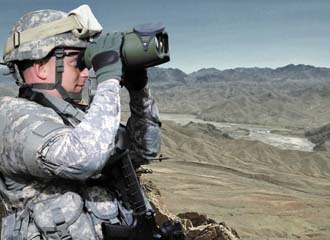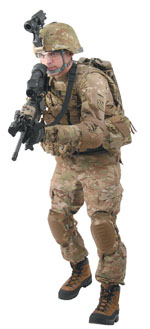Properly Equipping The Force
 |
The Joint Effects Targeting System (JETS) provides significantly enhanced lightweight, handheld precision targeting capability to joint forward observers and joint terminal attack controllers. JETS will improve targeting precision to complement the precision weapons used in theater. Because the system is conceptual, PEO Soldier uses the Northrop Grumman Mark VIIE pictured here as a graphical representation. |
The U.S. Army’s Program Executive Office Soldier is working with a focused fervor to carry out its responsibility to refine the development of and supply virtually every piece of equipment soldiers wear or carry. As troops engage in persistent conflicts around the globe, they require a new set of technologies to achieve their missions. To ensure victory on the battlefield, these tools must make forces more lethal, survivable, sustainable and agile. Office personnel are working to ensure they do just that, whether the situation calls for a new uniform or a state-of-the-art technical device.
Developing the best equipment and fielding it quickly is the primary purpose of Program Executive Office (PEO) Soldier. Its “soldier as a system” approach results in an overall systematic design that benefits warfighters by enhancing their ability to accomplish individual and collective tasks. The office’s responsibilities encompass more than 460 products for development, acquisition, fielding and improvement to fill the gaps experienced by troops in the field. Efforts support soldiers as well as partners such as the Air Force, Marine Corps and special operations forces.
Different authorities in the office work on different facets of troops’ gear. Product Manager (PM) Soldier Weapons, for example, has several major projects underway, including the M-4 improvement plan and an upcoming request for proposal (RFP) for the production of additional Common Remotely Operated Weapon Station (CROWS) systems. The RFP is anticipated in the third quarter of fiscal year 2011, and the contract is based on the same requirements as the current system. PM Soldier Weapons continues to field more stations each month in the meantime.
CROWS is a stabilized mount containing a sensor suite and fire control software, allowing on-the-move target acquisition and first-burst target engagement. It can engage targets in day and night conditions, and the sensor suite includes a daytime video camera, thermal camera and laser rangefinder. CROWS is designed to mount on any tactical vehicle and supports the MK19 grenade machine gun, .50-caliber M2 machine gun, M240B machine gun and M249 squad automatic weapon.
PM Soldier Protection and Individual Equipment is working on an effort of a different kind as it fields operation Enduring Freedom camouflage-pattern uniforms. The group also is focusing on a new generation of helmet sensors as well as the Non-Maneuverable Canopy (T-11) and Maneuverable Canopy 6 (MC-6) parachute systems. The T-11 Personnel Parachute System is the first wholesale modernization of the tactical parachute system since the 1950s according to PEO Soldier. It provides airborne soldiers with a more stable, safer rate of descent that reduces landing injuries and enables the wearer to carry a heavier load. The MC-6 Personnel Parachute System is a new tactical, static-line-deployed, steerable personnel parachute system that replaces the legacy MC-1 series parachute equipment. It enables the parachuting soldier to steer toward a specific impact point in the drop zone. It has several improvements over the system it replaces and is designed to operate at higher altitudes with heavier weights.
More technologically advanced experimentation is taking place in PM Soldier Warrior, which is focusing on a limited user test of the Nett Warrior system scheduled to be fielded in the fourth quarter of fiscal year 2010. The system, which includes hardware and software, should provide enhanced situational awareness to ground troops. Also falling under PM Soldier Warrior is ongoing theater support for Land Warrior and low-rate initial production and testing for the Aircraft Wireless Intercom System.
The PM for Soldier Precision Targeting Devices is developing high-tech solutions to battlefield problems as well. The main project in the division is the Joint Effects Targeting System (JETS), which received Milestone A approval in July. JETS provides a significantly enhanced lightweight, handheld precision targeting capability to joint forward observers and joint terminal attack controllers. In addition to improving accuracy, the system will reduce the 35-pound weight of current comparable systems to 15 pounds. “This is a game-changing enhancement for dismounted soldiers operating in rugged environments in which precision and minimization of collateral damage are imperative,” says Lt. Col. Mike Traxler,
The lighter weight of JETS will make it practical for platoons to carry instead of leaving a larger system back at the company level, which would push capability forward on the battlefield. The alterations from the former systems make it more useful for soldiers and enable platoons to establish targeting requirements for precision weapons more quickly and accurately. The result will be decreased time frames for putting weapons on target and reduced collateral damage. “A couple minutes of time on target is a pretty big deal when you’re the guy being shot at,” Col. Traxler says.
The colonel’s deputy, Nick Nickerson, explains the relationship between his team’s work and the weapons in use today, saying, “We’re trying to get precision targeting to the field so we can make use of precision weapons. We want to get the bad guy. We want to get him the first time. And we don’t want collateral damage.”
Reducing size, weight and power draw of equipment is one of the major focuses for all of PEO Soldier. With many troops in battle conditions carrying more than 100 pounds, often in extreme heat, finding ways to reduce their load is of concern for the Army and its sister services.
 |
PEO Soldier is working on more than 460 products to field to troops in theater. Some projects involve high-tech devices, but others involve more basic needs. To protect troops better in Afghanistan, the office is working to field operation Enduring Freedom camouflage-pattern uniforms. |
More cutting-edge technology refinement is being carried out by PM Soldier Maneuver Sensors. A project with major impacts to the Army’s fighting formations is the development of Enhanced Night Vision Goggles (ENVGs). Lt. Col. Chris Schneider,
Developers expect the tools to increase combat identification and reduce fratricide. “It will be a significant piece of kit, especially in
In addition to improving sight in obscured conditions, PM Soldier Maneuver Sensors is helping warfighters to see through solid material. The Sense Through the Wall project is a first-of-its-kind technology that measures approximately the size of a standard brick and uses Doppler radar to detect personnel through a wall up to 20 meters away. “It prevents soldiers from having to enter buildings unnecessarily and potentially running into booby traps and putting themselves at risk,” Col. Schneider explains. It also will enable soldiers to cover more ground and reduce exposure. The project currently has achieved Milestone B status. The colonel says the technology has proved itself to be “very effective,” and more testing will start in about four months.
All of the technology in the field and in development presents soldiers and developers with a challenge—integration. As devices become more complex and expensive, personnel have to make serious decisions about how to deploy and employ them. Col. Traxler explains that gadgets such as iPods or iPhones are intuitive for users and that “we need to be designing high technology in the same way.” Soldiers often carry five or six electronic devices that they need to operate simultaneously. Col. Traxler says these troops are intelligent, but are becoming overtaxed. New products must integrate with what troops already use if the equipment is to become effective on the battlefield.
Deciding what those new tools should be is a challenge that extends beyond the PEO. According to Col. Schneider, the office has basically two ways of taking care of soldiers’ needs. The first is through formal Army requirements processes; the other involves more rapidly fielding a solution requested by a soldier or unit in the field. “Whether that becomes a long and enduring solution for the Army is not a decision we make,” he says.
The program office works to maintain a dialog with end users to help ensure the equipment they receive actually helps to solve problems. One of the challenges for the developers at PEO Soldier is balancing the official requirements process against opinion from the field.
To support users better and to adjust to U.S. Defense Department guidance changes, the office continuously refines and adapts existing processes. Recently, focus has been placed on refining technology road maps through close interaction between the program management, laboratory and combat development communities. Col. Traxler says, “We continue to improve our processes and system for tracking program execution and earned value management and are improving tracking and sharing of information via SharePoint and other information-sharing mechanisms.”
In fiscal year 2010, the PEO revamped part of its acquisition process when a team from the Natick Soldier Research, Development and
Col. Traxler explains that his PM’s relationship with the Army Fires Center of Excellence, the Maneuver Center of Excellence and the end user is essential to success. Another way in which the PEO ensures that the millions it spends results in the right solutions is by working closely with research laboratories to best transition research technology into a program of record. “It’s a pretty tough thing to do,” Col. Traxler says. Because the office is focused on providing solutions, it only takes over mature projects. “When it gets to us, it better get into the field,” the colonel states.
Col. Traxler and his team work with partners outside the military as well. “We have a strong relationship with the MIT Institute for Soldier Nanotechnologies, Johns Hopkins Applied Physics Lab and numerous partners in development of the latest technologies,” he states. “Industry continues to be a vital partner in developing and delivering game-changing technology to our users.”
Working with sister services also has become increasingly important over time as military operations have moved away from Cold War tactics and become more focused on interoperability. Though sharing on the battlefield has proved successful in many ways, it adds to the difficulty of creating systems because each branch has its own approach and technology that later must be connected in the battlespace. By keeping work joint not only in the field but also during development, the military can integrate systems with one another in theater better. Teams within PEO Soldier also cross-collaborate as necessary.
Other trends influencing PEO Soldier’s efforts include those within the command, control, communications and computers field to provide superior decision making ability and intelligent network decision agents to link troops seamlessly into the battlefield network. Current and future system technologies from the office will provide material solutions to protect, sustain and equip troops coupled with nonmaterial solutions to enhance human performance. Col. Traxler explains that many of the technological aspects of soldiers’ needs, such as reduced size, power draw and weight, remain constant, but that developers must be responsive and adaptive to changes in warfighter requirements and emerging applications for existing technology.
WEB RESOURCES
PEO Soldier: https://peosoldier.army.mil
Natick Soldier Research, Development and
MIT Institute for Soldier Nanotechnologies: http://web.mit.edu/isn




Comments